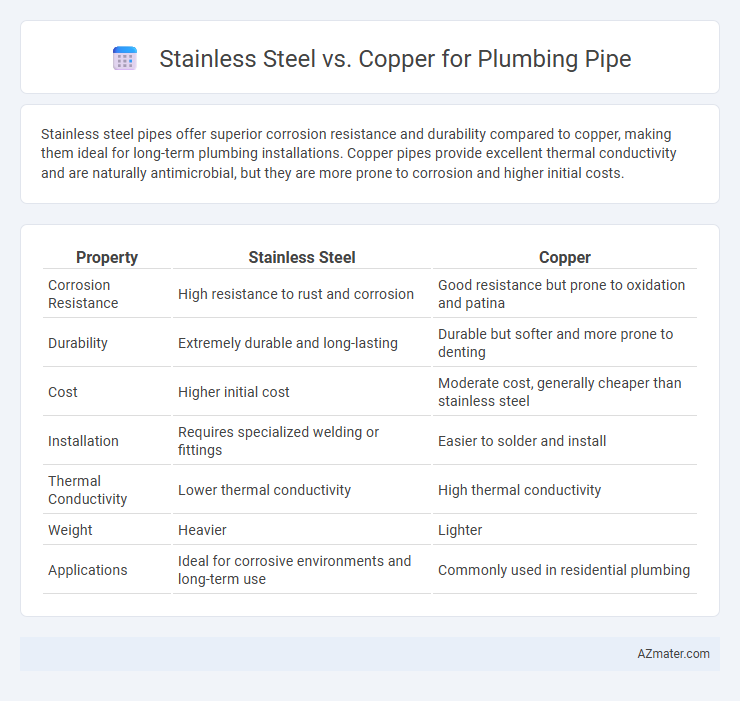Stainless steel pipes offer superior corrosion resistance and durability compared to copper, making them ideal for long-term plumbing installations. Copper pipes provide excellent thermal conductivity and are naturally antimicrobial, but they are more prone to corrosion and higher initial costs.
Table of Comparison
| Property | Stainless Steel | Copper |
|---|---|---|
| Corrosion Resistance | High resistance to rust and corrosion | Good resistance but prone to oxidation and patina |
| Durability | Extremely durable and long-lasting | Durable but softer and more prone to denting |
| Cost | Higher initial cost | Moderate cost, generally cheaper than stainless steel |
| Installation | Requires specialized welding or fittings | Easier to solder and install |
| Thermal Conductivity | Lower thermal conductivity | High thermal conductivity |
| Weight | Heavier | Lighter |
| Applications | Ideal for corrosive environments and long-term use | Commonly used in residential plumbing |
Introduction to Plumbing Pipe Materials
Stainless steel and copper are two popular materials used in plumbing pipes, each offering distinct advantages for water supply systems. Stainless steel provides exceptional corrosion resistance, high strength, and durability, making it suitable for both residential and industrial plumbing. Copper pipes are renowned for their excellent thermal conductivity, natural antimicrobial properties, and ease of installation, contributing to a long-lasting and efficient plumbing infrastructure.
Overview of Stainless Steel Pipes
Stainless steel pipes offer exceptional corrosion resistance, durability, and strength, making them ideal for plumbing systems in both residential and commercial settings. Unlike copper, stainless steel withstands extreme temperatures and pressure variations without degrading or leaching harmful substances. Its low maintenance requirements and long service life contribute to lower overall costs despite a higher initial investment.
Overview of Copper Pipes
Copper pipes offer excellent corrosion resistance and natural antimicrobial properties, making them ideal for plumbing systems requiring durability and hygiene. They provide superior thermal conductivity, which enhances hot water delivery efficiency, and are flexible enough to accommodate complex pipe layouts without compromising strength. Copper's long life span and recyclability contribute to its cost-effectiveness and environmental sustainability in residential and commercial plumbing applications.
Durability and Lifespan Comparison
Stainless steel plumbing pipes offer superior durability with high resistance to corrosion, rust, and extreme temperatures, resulting in a lifespan of up to 50 years or more. Copper pipes, while also durable and resistant to corrosion, typically last between 20 to 50 years but are more susceptible to acidic water and pinhole leaks over time. Choosing stainless steel ensures enhanced longevity and reduced maintenance compared to copper in harsh or variable environmental conditions.
Corrosion Resistance: Stainless Steel vs Copper
Stainless steel offers superior corrosion resistance in plumbing systems due to its chromium content, which forms a passive oxide layer preventing rust and degradation. Copper pipes naturally resist corrosion and have antimicrobial properties, but they are vulnerable to acidic water and certain soil conditions. Choosing between stainless steel and copper for plumbing depends on the water chemistry and environmental factors impacting long-term durability.
Cost Analysis and Budget Considerations
Stainless steel plumbing pipes typically cost more upfront than copper due to higher material and manufacturing expenses, with prices ranging from $3 to $8 per foot compared to copper's $2 to $5 per foot. Budget considerations must include longevity and maintenance costs; stainless steel offers greater corrosion resistance and durability, potentially lowering replacement frequency and overall lifecycle expenses. Copper pipes provide excellent reliability and thermal conductivity but may incur higher repair costs from corrosion or leaks over time, impacting long-term budget planning.
Installation Process and Flexibility
Stainless steel plumbing pipes require specialized tools and welding skills for installation, making the process more labor-intensive compared to copper. Copper pipes offer greater flexibility, allowing easier bending and fitting around obstacles without additional fittings, which reduces installation time and complexity. The corrosion resistance of stainless steel provides long-term durability, but copper's malleability often results in faster and more adaptable plumbing installations.
Health and Safety Factors
Stainless steel plumbing pipes offer superior resistance to corrosion and do not leach harmful metals, ensuring safer drinking water compared to copper, which can release trace amounts of copper ions potentially causing gastrointestinal issues. Stainless steel's non-porous surface inhibits bacterial growth, decreasing the risk of biofilm formation and waterborne diseases, while copper requires regular maintenance to prevent oxidation and microbial contamination. Both materials meet safety standards, but stainless steel is favored in environments demanding long-term durability and minimal health risks.
Environmental Impact and Sustainability
Stainless steel plumbing pipes offer superior corrosion resistance and longevity, reducing the frequency of replacements and minimizing waste in landfills. Copper pipes are recyclable and possess natural antimicrobial properties, but their extraction and refinement require significant energy and contribute to environmental degradation. Opting for stainless steel, which often contains recycled content and maintains structural integrity over decades, aligns more closely with sustainability goals in modern plumbing systems.
Choosing the Right Material for Your Plumbing Needs
Stainless steel and copper pipes offer distinct advantages for plumbing, with stainless steel providing superior corrosion resistance and durability in harsh environments, while copper excels in thermal conductivity and antibacterial properties. Choosing the right material depends on factors such as water quality, budget, and specific application requirements, where stainless steel is ideal for longevity and copper is preferred for its ease of installation and natural antimicrobial features. Understanding these characteristics ensures an optimized plumbing system tailored to performance and maintenance needs.

Infographic: Stainless steel vs Copper for Plumbing pipe
 azmater.com
azmater.com